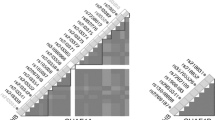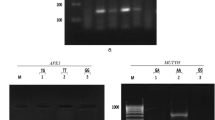Abstract
Polymorphisms in DNA repair and cell cycle genes contribute to increased breast cancer (BC) risk. Their association and interaction in relation to betel quid and tobacco chewing habits need exhaustive multi-analytical investigation to explain BC predisposition due to DNA damage. Polymorphism in TP53-72Arg>Pro, RAD51-135G>C, BRCA2, and CCND1-G870A were examined in 204 BC cases and 217 controls from Northeast Indian population. Multifaceted analytic approaches were used to explore relationships between polymorphisms, tobacco history, and BC susceptibility. Betel quid chewing was identified as the predominant risk factor. CCND-AA and dominant model showed protection towards BC in betel quid chewer (BQC) [(0.28 (0.10–0.77), 0.01 and 0.32 (0.12–0.81), 0.01)] and non-betel quid chewers (NBQC) [(0.26 (0.09–0.78), 0.01 and 0.37 (0.16–0.87), 0.02)]. TP53-Pro/Pro genotype showed protection towards BC in NBQC (0.29 (0.10–0.81), p = 0.01) and (0.51 (0.32–0.80), p = 0.003, respectively). RAD51-C allele was associated with BC risk (2.03 (1.26–3.30) 0.002) in BQC. Two BQC cases had BRCA2 8415G>T:K2729N mutation in Exon18. MDR analysis showed best four locus model with TBA 0.6765 (0.005) and CVC of 10/10 in NBQC. Interaction diagram concurred the interactions between TP53 and RAD51 (1.32 %) with independent effect (1.89 %) of CCND1in NBQC. In CART analysis, BQC with CCND1 GG genotype were at risk (OR = 33.0; 95 % CI = 6.08–179.07), p < 0.001) followed by combination of BQC, CCND1, No-Smk, and Alc (OR = 42.00; 95 % CI = 5.11–345.11, p < 0.001). Risk was also observed in BQC, CCND1, No-Smk, Non-Alc, and TP53 combination (OR = 14.84; 95 % CI = 3.13–70.34, p < 0.001) and BQC, CCND1, No-Smk, Non-Alc, TP53 (OR = 9.40; 95 % CI = 1.99–44.34, p < 0.001). NBQC group showed risk with combination of NBQC and TP53 (OR = 5.54; 95 % CI = 1.11–27.42, p = 0.03). Genetic variants in DNA repair and cell cycle genes contribute to BC risk through gene–gene and gene–environmental interactions.


Similar content being viewed by others
References
Gajalakshmi V, Mathew A, Brennan P, Rajan B, Kanimozhi VC, Mathews A, et al. Breastfeeding and breast cancer risk in India: a multicenter case-control study. Int J Cancer. 2009;125:662–5.
Nandakumar A, Ramnath T, Chaturvedi M. The magnitude of cancer breast in India: a summary. Indian J Surg Oncol. 2010;1:8–9.
Kaushal M, Mishra AK, Raju BS, Ihsan R, Chakraborty A, Sharma J, et al. Betel quid chewing as an environmental risk factor for breast cancer. Mutat Res. 2010;703:143–8.
Kaushal M, Mishra AK, Sharma J, Zomawia E, Kataki A, Kapur S, et al. Genomic alterations in breast cancer patients in betel quid and non betel quid chewers. PLoS One. 2012;7:e43789.
Martin MB, Reiter R, Johnson M, Shah MS, Iann MC, Singh B, et al. Effects of tobacco smoke condensate on estrogen receptor-alpha gene expression and activity. Endocrinology. 2007;148:4676–86.
Smith TR, Levine EA, Perrier ND, Miller MS, Freimanis RI, Lohman K, et al. DNA-repair genetic polymorphisms and breast cancer risk. Cancer Epidemiol Biomarkers Prev. 2003;12:1200–4.
Seedhouse C, Faulkner R, Ashraf N, Das-Gupta E, Russell N. Polymorphisms in genes involved in homologous recombination repair interact to increase the risk of developing acute myeloid leukemia. Clin Cancer Res. 2004;10:2675–80.
Sliwinski T, Renata Krupa R, Majsterek I, Rykala J, Kolacinska A, Morawiec Z, et al. Polymorphisms of the BRCA2 and RAD51 genes in breast cancer. Breast Cancer Res Treat. 2005;94:105–9.
Siddique M, Sabapathy K. Trp53-dependent DNA-repair is affected by the codon 72 polymorphism. Oncogene. 2006;25:3489–500.
Bewick MA, Conlon MSC, Lafrenie RM. Polymorphisms in XRCC1, XRCC3, and CCND1 and survival after treatment for metastatic breast cancer. J Clin Oncol. 2006;24:5645–54.
Levy-Lahad E, Lahad A, Eisenberg S, Dagan E, Paperna T, Kasinetz L, et al. A single nucleotide polymorphism in the RAD51 gene modifies cancer risk in BRCA2 but not BRCA1 carriers. Proc Natl Acad Sci U S A. 2001;98:3232–6.
Porter TR, Richards FM, Houlston RS, Evans DG, Jankowski JA, Macdonald F, et al. Contribution of cyclin d1 (CCND1) and E-cadherin (CDH1) polymorphisms to familial and sporadic colorectal cancer. Oncogene. 2002;21:1928–33.
Srivastava A, Sharma KL, Srivastava N, Misra S, Mittal B. Significant role of estrogen and progesterone receptor sequence variants in gallbladder cancer predisposition: a multi-analytical strategy. PLoS One. 2012;7:e40162.
Ihsan R, Chauhan PS, Mishra AK, Yadav DS, Kaushal M, Sharma JD, et al. Multiple analytical approaches reveal distinct gene-environment interactions in smokers and non smokers in lung cancer. PLoS One. 2011;6:e29431.
Nair U, Bartsch H, Nair J. Alert for an epidemic of oral cancer due to use of the betel quid substitutes gutkha and pan masala: a review of agents and causative mechanisms. Mutagenesis. 2004;19:251–62.
Chatterjee A, Deb S. Genotoxic effect of arecoline given either by the peritoneal or oral route in murine bone marrow cells and the influence of N-acetylcysteine. Cancer Lett. 1999;139:23–31.
Lu C, Dong J, Ma H, Jin G, Hu Z, Peng Y, et al. CCND1 G870A polymorphism contributes to breast cancer susceptibility: a meta-analysis. Breast Cancer Res Treat. 2009;116:571–5.
Hong Y, Eu KW, Seow-Choen F, Fook-Chong S, Cheah PY. GG genotype of cyclin D1 G870A polymorphism is associated with increased risk and advanced colorectal cancer in patients in Singapore. Eur J Cancer. 2005;41:1037–44.
Jia A, Gong J, Li Y, Hao Z, Chang X, Dai F, et al. GG genotype of cyclin D1 G870A polymorphism is associated with non-cardiac gastric cancer in a high-risk region of China. Scand J Gastroenterol. 2008;43:1353–9.
Catarino R, Matos A, Pinto D, Pereira D, Craveiro R, Vasconcelos A, et al. Increased risk of cervical cancer associated with cyclin D1 gene A870G polymorphism. Cancer Genet Cytogenet. 2005;160:49–54.
Catarino RJ, Breda E, Coelho V, Pinto D, Sousa H, Lopes C, et al. Association of the A870G cyclin D1 gene polymorphism with genetic susceptibility to nasopharyngeal carcinoma. Head Neck. 2006;28:603–8.
Matthias C, Branigan K, Jahnke V, Leder K, Haas J, Heighway J, et al. Polymorphism within the cyclin D1 gene is associated with prognosis in patients with squamous cell carcinoma of the head and neck. Clin Cancer Res. 1998;4:2411–8.
Matthias C, Jahnke V, Jones PW, Hoban PR, Alldersea JE, Worrall SF, et al. Cyclin D1, glutathione S-transferase, and cytochrome P450 genotypes and outcome in patients with upper aerodigestive tract cancers: assessment of the importance of individual genes using multivariate analysis. Cancer Epidemiol Biomarkers Prev. 1999;8:815–23.
Bala S, Peltomaki P. CYCLIN D1 as a genetic modifier in hereditary nonpolyposis colorectal cancer. Cancer Res. 2001;61:6042–5.
Comstock CE, Augello MA, Benito RP, Karch J, Tran TH, Utama FE, et al. Cyclin D1 splice variants: polymorphism, risk, and isoform-specific regulation in prostate cancer. Clin Cancer Res. 2009;15:5338–49.
Krupa R, Sobczuk A, Poplawski T, Wozniak K, Blasiak J. DNA damage and repair in endometrial cancer in correlation with the hOGG1 and RAD51 genes polymorphism. Mol Biol Rep. 2011;38:1163–70.
Werbrouck J, De Ruyck K, Duprez F, Van Eijkeren M, Rietzschel E, Bekaert S, et al. Single-nucleotide polymorphisms in DNA double-strand break repair genes: association with head and neck cancer and interaction with tobacco use and alcohol consumption. Mutat Res. 2008;656:74–81.
Kaushal M, Chattopadhyay I, Phukan R, Purkayastha J, Mahanta J, Kapur S, et al. Contribution of germ line BRCA2 sequence alterations to risk of familial esophageal cancer in a high-risk area of India. Dis Esophagus. 2010;23:71–5.
Marx G. Possible function found for breast cancer genes. Science. 1997;276:531–2.
Ceschi M, Sun CL, Van Den Berg D, Koh WP, Yu MC, Probst-Hensch N. The effect of cyclin D1 (CCND1) G870A-polymorphism on breast cancer risk is modified by oxidative stress among Chinese women in Singapore. Carcinogenesis. 2005;26:1457–64.
Costa S, Pinto D, Pereira D, Rodrigues H, Cameselle-Teijeiro J, Medeiros R, et al. Importance of TP53 codon 72 and intron 3 duplication 16bp polymorphisms in prediction of susceptibility on breast cancer. BMC Cancer. 2008;8:32.
Gochhait S, Bukhari SI, Bairwa N, Vadhera S, Darvishi K, Raish M, et al. Implication of BRCA2–26G > A 5′ untranslated region polymorphism in susceptibility to sporadic breast cancer and its modulation by p53 codon 72 Arg > Pro polymorphism. Breast Cancer Res. 2007;9:R71.
Buchhop S, Gibson MK, Wang XW, Wagner P, Sturzbecher HW, Harris CC. Interaction of p53 with the human Rad51 protein. Nucleic Acids Res. 1997;25:3868–74.
Zhai R, Chen F, Liu G, Su L, Kulke MH, Asomaning K, et al. Interactions among genetic variants in apoptosis pathway genes, reflux symptoms, body mass index, and smoking indicate two distinct etiologic patterns of esophageal adenocarcinoma. J Clin Oncol. 2010;28:2445–51.
Briollais L, Wang Y, Rajendram I, Onay V, Shi E, Knight J, et al. Methodological issues in detecting gene-gene interactions in breast cancer susceptibility: a population-based study in Ontario. BMC Med. 2007;5:22.
Acknowledgments
This work was supported by funding given by the Indian Council of Medical Research (ICMR), New Delhi, India.
Conflicts of interest
None
Author information
Authors and Affiliations
Corresponding author
Electronic supplementary material
Below is the link to the electronic supplementary material.
Supplementary Table 1
(DOC 56 kb)
Supplementary Table 2
(DOC 68 kb)
Supplementary Table 3
(DOC 40 kb)
Supplementary Fig. 1
DHPLC analysis showing heteroduplex peaks and homoduplex peaks in Exon27 of BRCA2 gene. The polymorphic variant was identified as 10462A>G: I3412V by sequencing (JPEG 389 kb)
Supplementary Fig. 2
DHPLC analysis showing heteroduplex homoduplex peaks in Exon18 of BRCA2 gene. The variant was identified as 8415G>T: K2729N in Exon18 of BRCA2 gene (JPEG 427 kb)
Supplementary Fig. 3
DHPLC analysis of −26G>A polymorphism. Heteroduplex peak shows samples with GA genotype and homoduplex peaks shows samples with AA genotype. Sequencing analysis of samples with Exon 2 variants depicting GA heterozygous and AA homozygous genotype of BRCA2 gene. (JPEG 537 kb)
Rights and permissions
About this article
Cite this article
Wasson, M.K., Chauhan, P.S., Singh, L.C. et al. Association of DNA repair and cell cycle gene variations with breast cancer risk in Northeast Indian population: a multiple interaction analysis. Tumor Biol. 35, 5885–5894 (2014). https://doi.org/10.1007/s13277-014-1779-2
Received:
Accepted:
Published:
Issue Date:
DOI: https://doi.org/10.1007/s13277-014-1779-2




